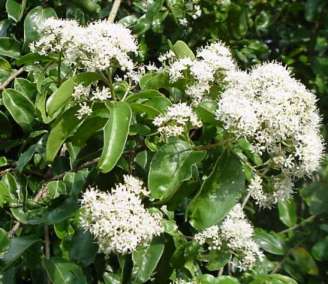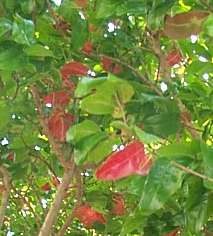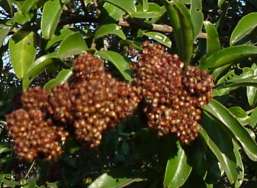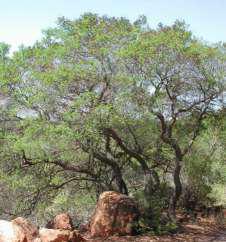Galpinia transvaalica
Galpinia transvaalica N.E.Br.
Family: Lythraceae
Common names: wild pride of India (Eng.); knoppieblaar (Afr.); UmDlampangele ( Zulu)
SA Tree No: 523
Introduction
This tree is part of a small family of herbs, small trees and shrubs found in subtropical and tropical regions. Its attractive flowerheads and coloured spring foliage make it a popular ornamental tree.

Description
Description
Galpinia transvaalica grows up to 6 m in height and is a multi-stemmed shrub or small tree. The stems are often crooked and the branches lie low. The bark is smooth and pale when young, but has a rough appearance and cracks into blocks when the tree is older.

The leaves are simple, opposite and have a glossy, dark to almost black appearance. They are 20-60 x 15-30 mm in size. The leaf apex is rounded and often notched; the margin is entire and noticeably wavy and the petioles are thick and thickset. Young leaves are coppery to reddish. The tree is very attractive in spring when the old leaves turn red before dropping and the coloured new leaves emerge. In late spring the tree may show a few red leaves hidden amongst the shiny new green foliage.
The flowers are white, up to 13 mm in diameter and borne in dense sprays at the end of branches. The bisexual floral parts occur in fives or sixes. The calyx is bell-shaped and divides into ovate lobes. The petals are crinkly, the ovary 2-chambered and the stamens are attached to the calyx tube. Flowers are present from November to May.

The fruit is a small, round capsule and 3-4 mm wide. It forms compact clusters that are reddish brown to black and is covered with a hard rind, which splits open to release winged seeds. Fruit appear from April to July.
Distribution and habitat
Distribution description
It occurs in low to medium altitudes in woodland and thickets from Zululand and Swaziland to Mpumalanga and Limpopo. This plant is an important fodder plant on cattle and game farms. The bunches of white flowers attract many insect species.
Ecology
Ecology
The hard wood is heavy, pale brown to yellowish brown. Antelope, elephant and giraffe browse the leaves. It is an important fodder plant on cattle and game farms. The flowers also attract flies and butterflies and this in turn attracts many insect-eating birds.
Uses
Use
This tree has good horticultural potential and is quite attractive as a hedge plant. It has a non-aggressive root system and can be planted close to walls and paved areas. The wild pride-of- India can be successfully planted in containers and makes excellent bonsai specimens.

Growing Galpinia transvaalica
Grow
Sow in trays filled with river sand. Cover the seed with a thin layer of fine sand and keep it moist. After 7-10 days seedlings will appear. Transplant in plastic bags when the plants have reached a 2-leaf stage. Keep the seedlings well protected from frost. This is a fast-growing plant and can grow up to 1m per year. Adult trees can withstand long periods of drought, but are sensitive to frost.
References
- Coates Palgrave, K. 1977. Trees of southern Africa. Struik, Cape Town.
- Joffe, P. 1993. The gardeners guide to South African plants. Tafelberg,Cape Town.
- Schmidt, E., Lotter, M. & McCleland, W. 2002. Trees and shrubs of Mpumalanga and Kruger National Park. Jacana, Johannesburg.
- Venter, F. & Venter, J. 1996. Making the most of indigenous trees. Briza Publications, Pretoria.
Credits
Linette Ferreira
Pretoria National Botanical Garden
November 2004
Plant Attributes:
Plant Type: Tree
SA Distribution: Gauteng, KwaZulu-Natal, Limpopo, Mpumalanga
Soil type: Sandy, Clay, Loam
Flowering season: Early Summer, Late Summer
PH: Neutral
Flower colour: White, Cream
Aspect: Full Sun, Shade, Morning Sun (Semi Shade), Afternoon Sun (Semi Shade)
Gardening skill: Easy
Special Features:
Horticultural zones









Rate this article
Article well written and informative
Rate this plant
Is this an interesting plant?
Login to add your Comment
Back to topNot registered yet? Click here to register.